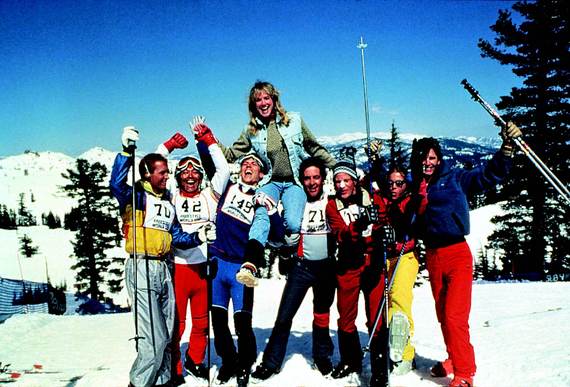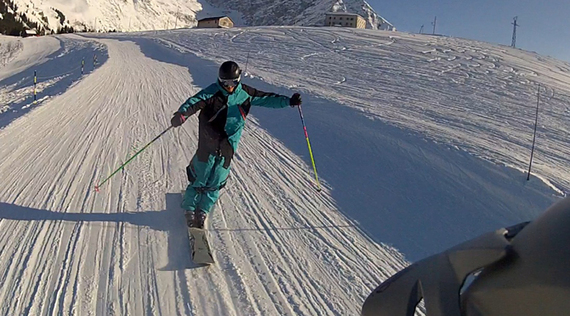I'm not really sure how it happened, but somehow I've had a blessed life so far. I met a beautiful girl at college, and while we were young and foolish, we made (against our parents' advice) what turned out to be the smart move of buying a cheap wrecked house up in the Highlands of Scotland. Now 30 years later, we're still here. Two of our three sons have left home; I'm turning 50 and have managed to make a career from researching and writing about ski resorts.
I've visited hundreds of ski areas over the years and my career has taken me from writing for guide books and magazines in the early 1980s, through the rise of personal computing and then the internet.
Looking back to those early years, I've been struck by what has and what hasn't changed about the ski industry in those three decades. Here are some thoughts:
Snow
I've been especially interested in climate change, trying to keep track of what's happening and what is predicted. I set up a website ten years ago that tries to keep track of what resorts are doing (it needs a make over). Today, resorts are still posting record snowfalls, proving that the snow is still falling. The bigger question is whether it falls as consistently and to such low elevations as it once did? You need to observe a lot of seasons to be able to tell and, luckily, 30 is quite a few.
There does seem to be more extremes of weather with huge falls, then drought. One evident change is the glacier retreat in the Alps. I remember summer skiing in Zermatt in 1984 and skiing right the way to the base station of the glacier lift. Now the ice ends nearly half a mile from there, and a special all-weather snowmaking system helps make the connection once the winter snow has gone.
What's also changed is our expectations. Time was, 30 years ago, we didn't know what the snow would be like: We just took a guess and hoped for the best. We didn't have snow reports; we didn't have web cams; hell, we didn't even have personal computers, let alone an internet connecting them. As I recall, when we arrived to resort and there was little or no snow, we did not complain but just went for a hike and enjoyed being there.
These days, I'm told by resort management that they have make snow in high traffic areas, even during a good winter with natural snowfall to ensure reliable cover all season. Customers no longer accept, "Sorry no snow."
Indoor Snow
When I first started out as a ski writer, there were no indoor snow centers. Although the opening of Ski Dubai has had the most attention, the first indoor snow slopes opened in the late 1980s simultaneously in Belgium, Australia and Japan. Since then, more than 80 have been built in 30 countries around the world. In fact, over the 30 years some have opened, traded for a decade or two, and closed again. But, there are still about 60 operational and new ones opening all the time.
Although underrated by some skiers and boarders, indoor snow centers have allowed tens of millions of city folk try snow sports, many of them getting hooked and going on to regular resorts when they might otherwise never have tried skiing.
Lift Tickets
In the past, you bought a ticket, which was a bit of cardboard on a bit of wire, from someone behind a desk in a little hut by the lifts. There was one price and that was that. Now, you get the best prices, usually by buying your ticket online in advance and downloading your ticket on to a magic electronic pass which not only opens lift gates for you, but sometimes even tracks you on the mountain and sends details of your location all around the world on social media. Liftopia offers some of the best values in lift tickets through the use of technology, although I still have my old cardboard tickets pinned on the wall back home.
Skis and Snowboards
Snowboarding was just getting started 30 years ago in terms of reaching the mass market. In fact, in the early 1980s, I remember monoskis were all the rage for a brief period. Through the 1980s and 1990s, it some convincing to ski resorts, along with the International Olympic Committee, that snowboarders deserved equal rights on their slopes.
Skiing on long straight skis began to look distinctly passe next to the cool, laid back boarding culture. The average age of skiers moved in to the 40s and predictions abounded that by the early 21st century, there'd be more boarders than skiers.
However, skiing reinvented itself, copying ski design from boards to make carving skis (about a foot shorter than the ones we used to use) that let skiers have fun in the terrain park, and fat skis to do a bit of free-riding too. Boarders still have the comfier boots though!
I could go on: advances in ski lifts, those slope side base villages at many leading U.S. resorts that didn't exist 20 or so years ago, the webcams that now points at slopes all around the world, countries like China, South Africa or Iraq which didn't have ski lifts 30 years ago, the rise of terrain parks and the introduction of snowboarding to the Olympics, and much, much, more, but you're probably getting bored listening to this old timer rant on so I'll let you get back to checking out the snow cams on Twitter...
This post originally ran on the Liftopia blog.
By Patrick "Snowhunter" Thorne, @snowhoper

